BUS705 - Innovation & Management: Responding to Business Forces
VerifiedAdded on 2023/04/20
|6
|1135
|153
Report
AI Summary
This report discusses how technological and economic forces impact business trends, requiring companies to innovate and make informed management decisions. It examines various management theories, including Theory X and Theory Y, scientific management theory, system management theory, and contingency management theory, and how they apply to strategic, tactical, and operational decision-making. The report emphasizes the importance of understanding these forces to minimize risks and optimize long-term business outcomes, highlighting the increasing global access to technology and its influence on business strategies. Desklib offers a platform to explore similar documents and solved assignments for students.
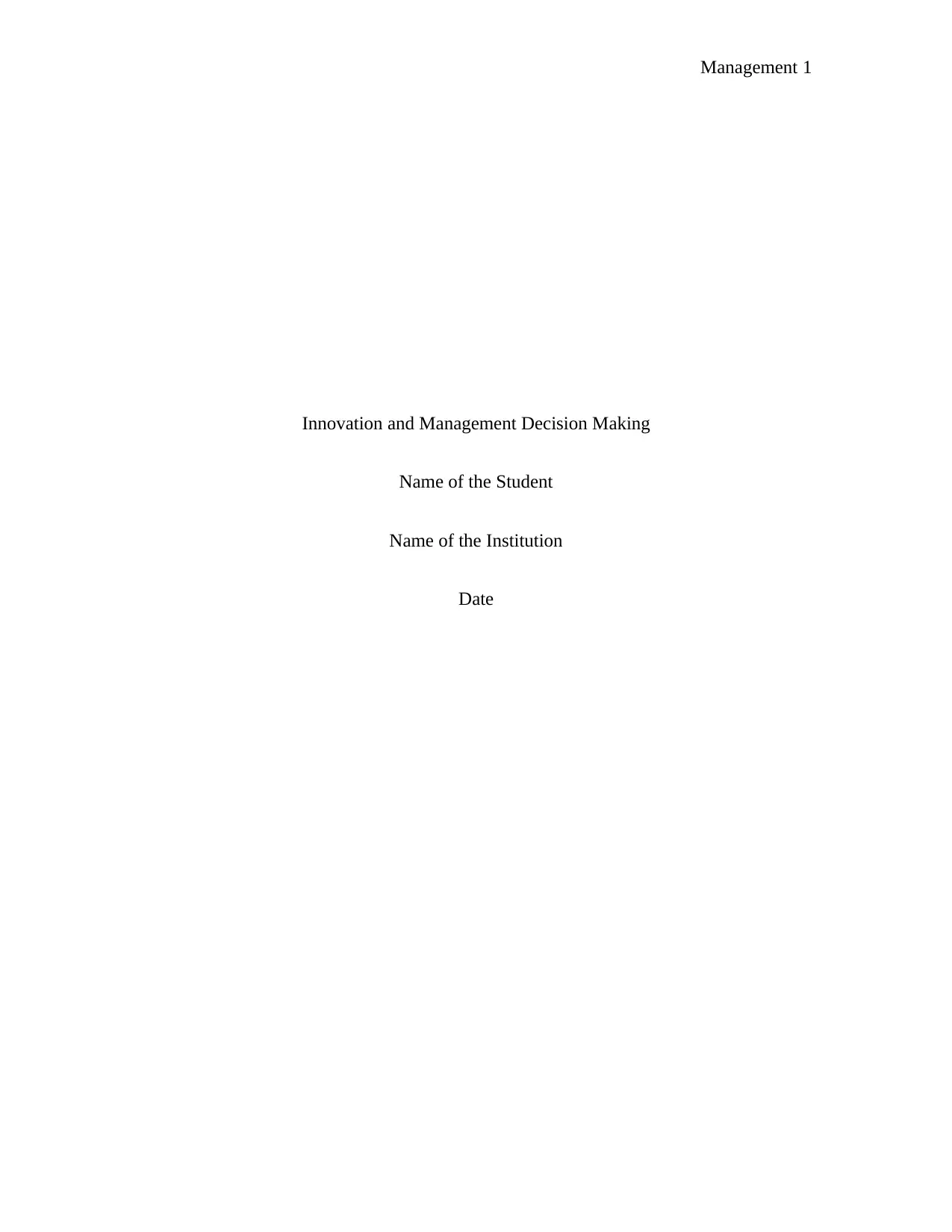
Management 1
Innovation and Management Decision Making
Name of the Student
Name of the Institution
Date
Innovation and Management Decision Making
Name of the Student
Name of the Institution
Date
Paraphrase This Document
Need a fresh take? Get an instant paraphrase of this document with our AI Paraphraser
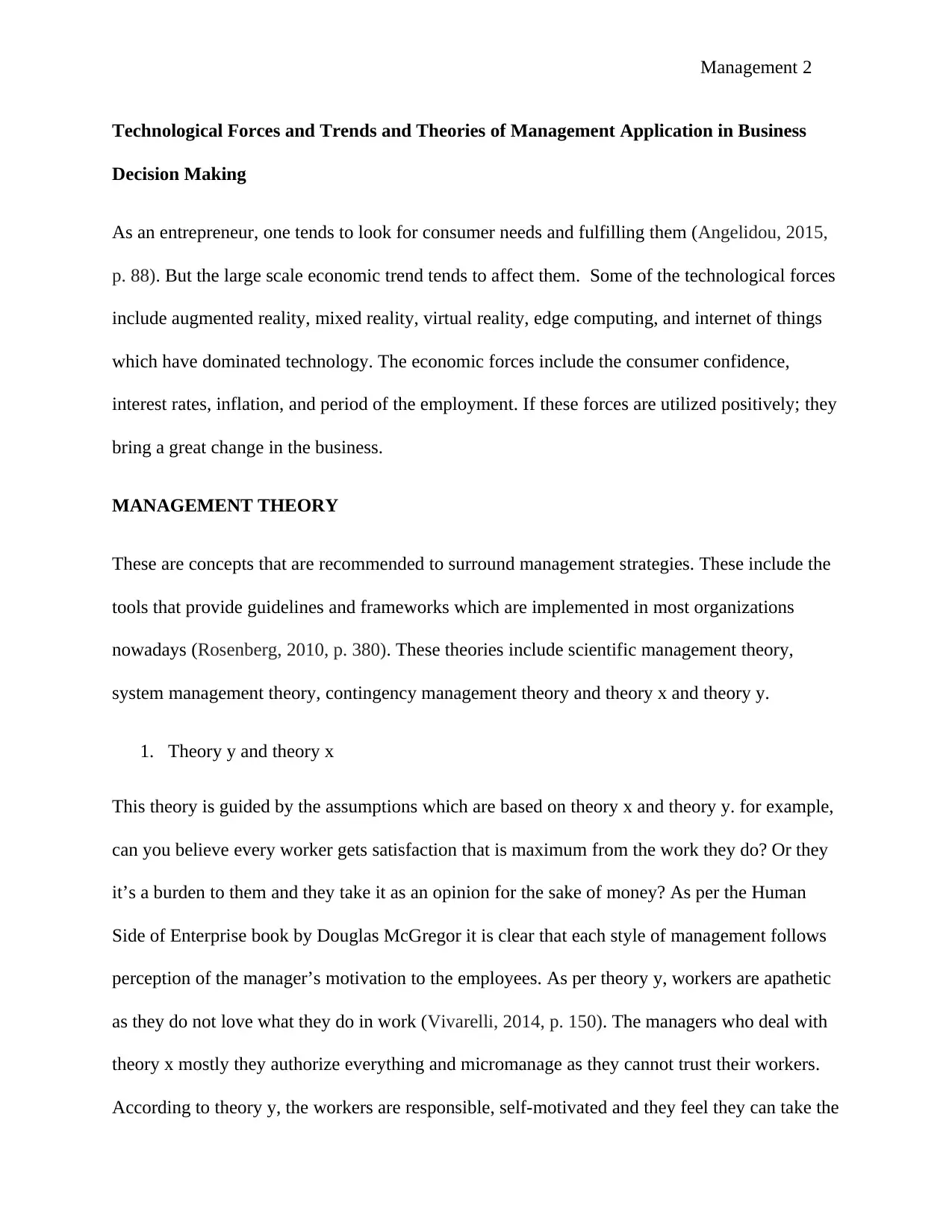
Management 2
Technological Forces and Trends and Theories of Management Application in Business
Decision Making
As an entrepreneur, one tends to look for consumer needs and fulfilling them (Angelidou, 2015,
p. 88). But the large scale economic trend tends to affect them. Some of the technological forces
include augmented reality, mixed reality, virtual reality, edge computing, and internet of things
which have dominated technology. The economic forces include the consumer confidence,
interest rates, inflation, and period of the employment. If these forces are utilized positively; they
bring a great change in the business.
MANAGEMENT THEORY
These are concepts that are recommended to surround management strategies. These include the
tools that provide guidelines and frameworks which are implemented in most organizations
nowadays (Rosenberg, 2010, p. 380). These theories include scientific management theory,
system management theory, contingency management theory and theory x and theory y.
1. Theory y and theory x
This theory is guided by the assumptions which are based on theory x and theory y. for example,
can you believe every worker gets satisfaction that is maximum from the work they do? Or they
it’s a burden to them and they take it as an opinion for the sake of money? As per the Human
Side of Enterprise book by Douglas McGregor it is clear that each style of management follows
perception of the manager’s motivation to the employees. As per theory y, workers are apathetic
as they do not love what they do in work (Vivarelli, 2014, p. 150). The managers who deal with
theory x mostly they authorize everything and micromanage as they cannot trust their workers.
According to theory y, the workers are responsible, self-motivated and they feel they can take the
Technological Forces and Trends and Theories of Management Application in Business
Decision Making
As an entrepreneur, one tends to look for consumer needs and fulfilling them (Angelidou, 2015,
p. 88). But the large scale economic trend tends to affect them. Some of the technological forces
include augmented reality, mixed reality, virtual reality, edge computing, and internet of things
which have dominated technology. The economic forces include the consumer confidence,
interest rates, inflation, and period of the employment. If these forces are utilized positively; they
bring a great change in the business.
MANAGEMENT THEORY
These are concepts that are recommended to surround management strategies. These include the
tools that provide guidelines and frameworks which are implemented in most organizations
nowadays (Rosenberg, 2010, p. 380). These theories include scientific management theory,
system management theory, contingency management theory and theory x and theory y.
1. Theory y and theory x
This theory is guided by the assumptions which are based on theory x and theory y. for example,
can you believe every worker gets satisfaction that is maximum from the work they do? Or they
it’s a burden to them and they take it as an opinion for the sake of money? As per the Human
Side of Enterprise book by Douglas McGregor it is clear that each style of management follows
perception of the manager’s motivation to the employees. As per theory y, workers are apathetic
as they do not love what they do in work (Vivarelli, 2014, p. 150). The managers who deal with
theory x mostly they authorize everything and micromanage as they cannot trust their workers.
According to theory y, the workers are responsible, self-motivated and they feel they can take the
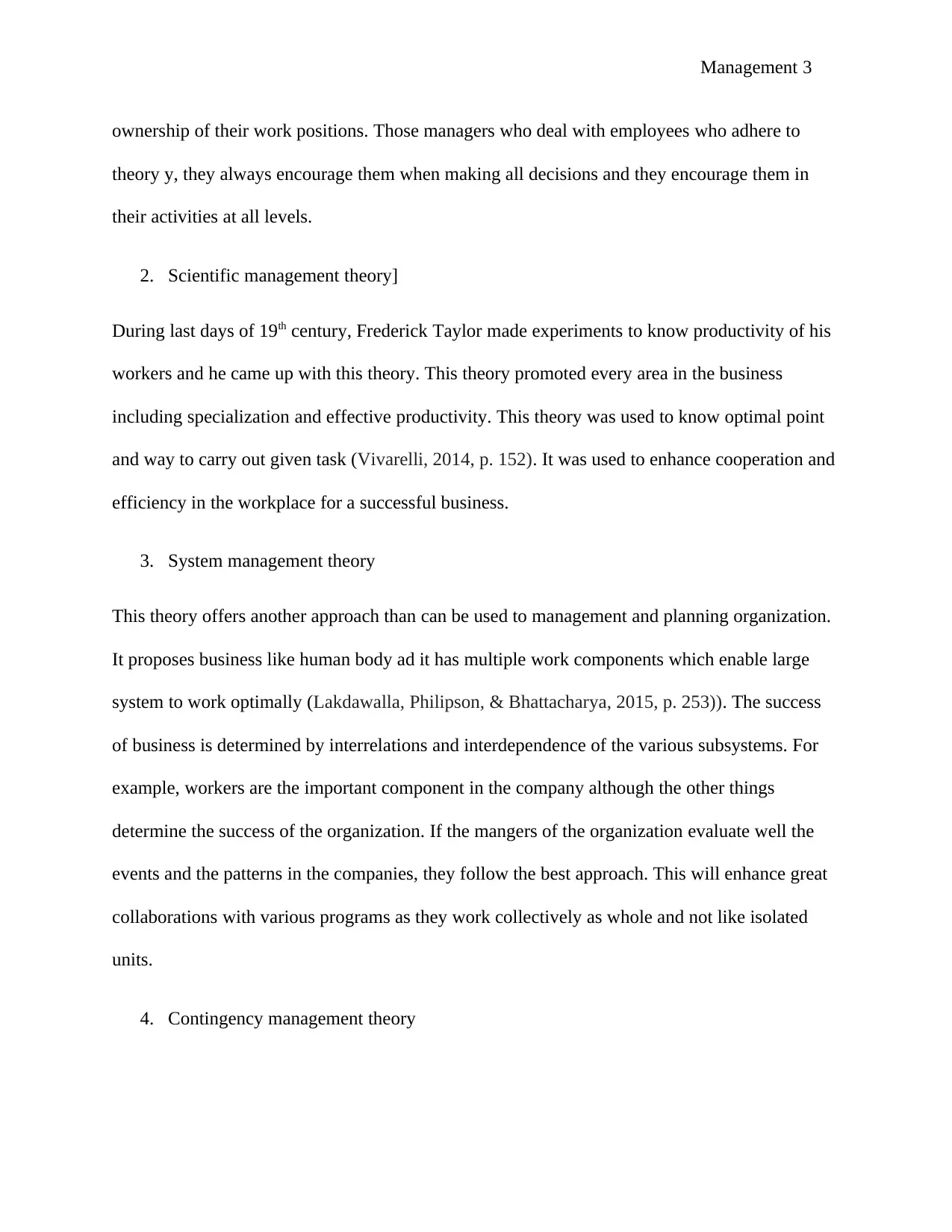
Management 3
ownership of their work positions. Those managers who deal with employees who adhere to
theory y, they always encourage them when making all decisions and they encourage them in
their activities at all levels.
2. Scientific management theory]
During last days of 19th century, Frederick Taylor made experiments to know productivity of his
workers and he came up with this theory. This theory promoted every area in the business
including specialization and effective productivity. This theory was used to know optimal point
and way to carry out given task (Vivarelli, 2014, p. 152). It was used to enhance cooperation and
efficiency in the workplace for a successful business.
3. System management theory
This theory offers another approach than can be used to management and planning organization.
It proposes business like human body ad it has multiple work components which enable large
system to work optimally (Lakdawalla, Philipson, & Bhattacharya, 2015, p. 253)). The success
of business is determined by interrelations and interdependence of the various subsystems. For
example, workers are the important component in the company although the other things
determine the success of the organization. If the mangers of the organization evaluate well the
events and the patterns in the companies, they follow the best approach. This will enhance great
collaborations with various programs as they work collectively as whole and not like isolated
units.
4. Contingency management theory
ownership of their work positions. Those managers who deal with employees who adhere to
theory y, they always encourage them when making all decisions and they encourage them in
their activities at all levels.
2. Scientific management theory]
During last days of 19th century, Frederick Taylor made experiments to know productivity of his
workers and he came up with this theory. This theory promoted every area in the business
including specialization and effective productivity. This theory was used to know optimal point
and way to carry out given task (Vivarelli, 2014, p. 152). It was used to enhance cooperation and
efficiency in the workplace for a successful business.
3. System management theory
This theory offers another approach than can be used to management and planning organization.
It proposes business like human body ad it has multiple work components which enable large
system to work optimally (Lakdawalla, Philipson, & Bhattacharya, 2015, p. 253)). The success
of business is determined by interrelations and interdependence of the various subsystems. For
example, workers are the important component in the company although the other things
determine the success of the organization. If the mangers of the organization evaluate well the
events and the patterns in the companies, they follow the best approach. This will enhance great
collaborations with various programs as they work collectively as whole and not like isolated
units.
4. Contingency management theory
⊘ This is a preview!⊘
Do you want full access?
Subscribe today to unlock all pages.

Trusted by 1+ million students worldwide
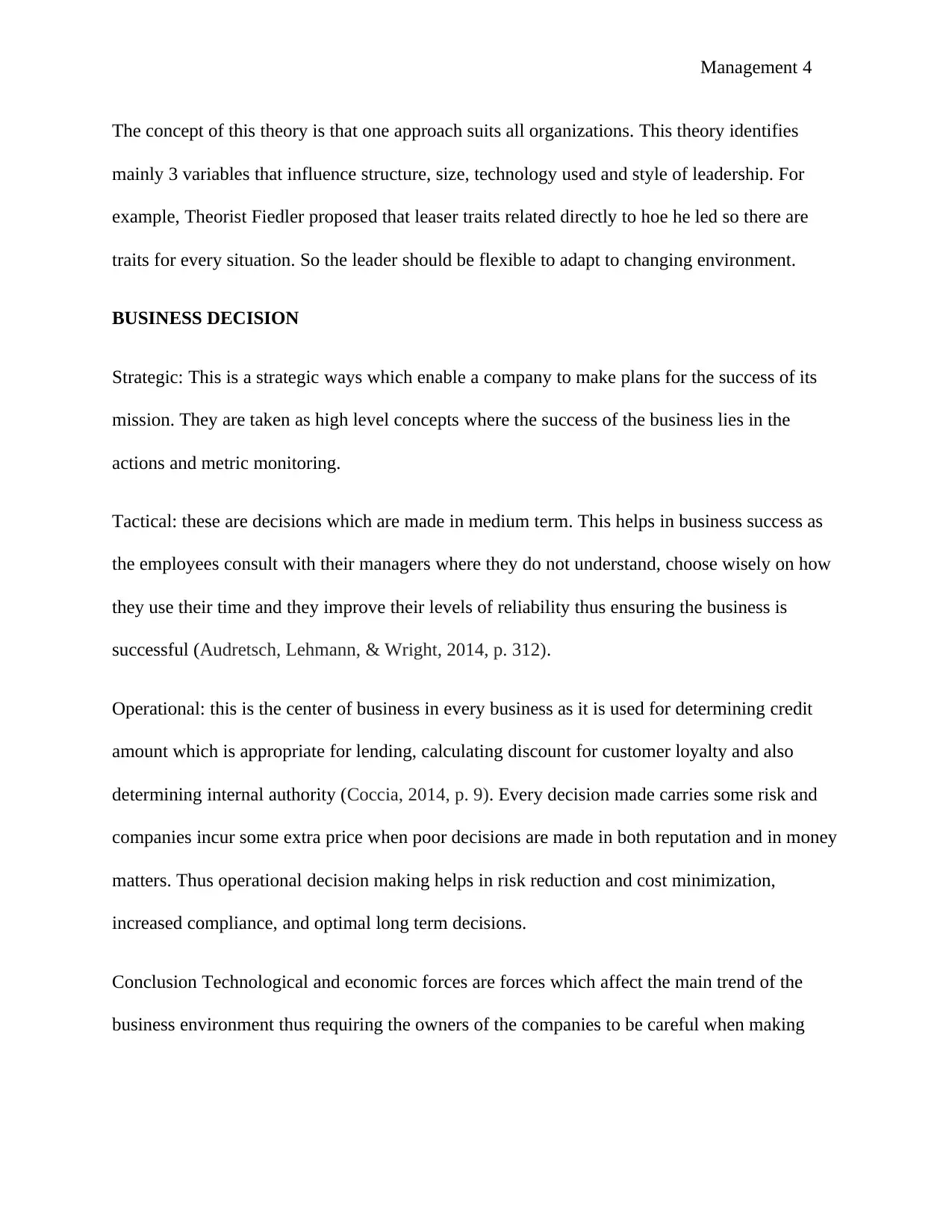
Management 4
The concept of this theory is that one approach suits all organizations. This theory identifies
mainly 3 variables that influence structure, size, technology used and style of leadership. For
example, Theorist Fiedler proposed that leaser traits related directly to hoe he led so there are
traits for every situation. So the leader should be flexible to adapt to changing environment.
BUSINESS DECISION
Strategic: This is a strategic ways which enable a company to make plans for the success of its
mission. They are taken as high level concepts where the success of the business lies in the
actions and metric monitoring.
Tactical: these are decisions which are made in medium term. This helps in business success as
the employees consult with their managers where they do not understand, choose wisely on how
they use their time and they improve their levels of reliability thus ensuring the business is
successful (Audretsch, Lehmann, & Wright, 2014, p. 312).
Operational: this is the center of business in every business as it is used for determining credit
amount which is appropriate for lending, calculating discount for customer loyalty and also
determining internal authority (Coccia, 2014, p. 9). Every decision made carries some risk and
companies incur some extra price when poor decisions are made in both reputation and in money
matters. Thus operational decision making helps in risk reduction and cost minimization,
increased compliance, and optimal long term decisions.
Conclusion Technological and economic forces are forces which affect the main trend of the
business environment thus requiring the owners of the companies to be careful when making
The concept of this theory is that one approach suits all organizations. This theory identifies
mainly 3 variables that influence structure, size, technology used and style of leadership. For
example, Theorist Fiedler proposed that leaser traits related directly to hoe he led so there are
traits for every situation. So the leader should be flexible to adapt to changing environment.
BUSINESS DECISION
Strategic: This is a strategic ways which enable a company to make plans for the success of its
mission. They are taken as high level concepts where the success of the business lies in the
actions and metric monitoring.
Tactical: these are decisions which are made in medium term. This helps in business success as
the employees consult with their managers where they do not understand, choose wisely on how
they use their time and they improve their levels of reliability thus ensuring the business is
successful (Audretsch, Lehmann, & Wright, 2014, p. 312).
Operational: this is the center of business in every business as it is used for determining credit
amount which is appropriate for lending, calculating discount for customer loyalty and also
determining internal authority (Coccia, 2014, p. 9). Every decision made carries some risk and
companies incur some extra price when poor decisions are made in both reputation and in money
matters. Thus operational decision making helps in risk reduction and cost minimization,
increased compliance, and optimal long term decisions.
Conclusion Technological and economic forces are forces which affect the main trend of the
business environment thus requiring the owners of the companies to be careful when making
Paraphrase This Document
Need a fresh take? Get an instant paraphrase of this document with our AI Paraphraser
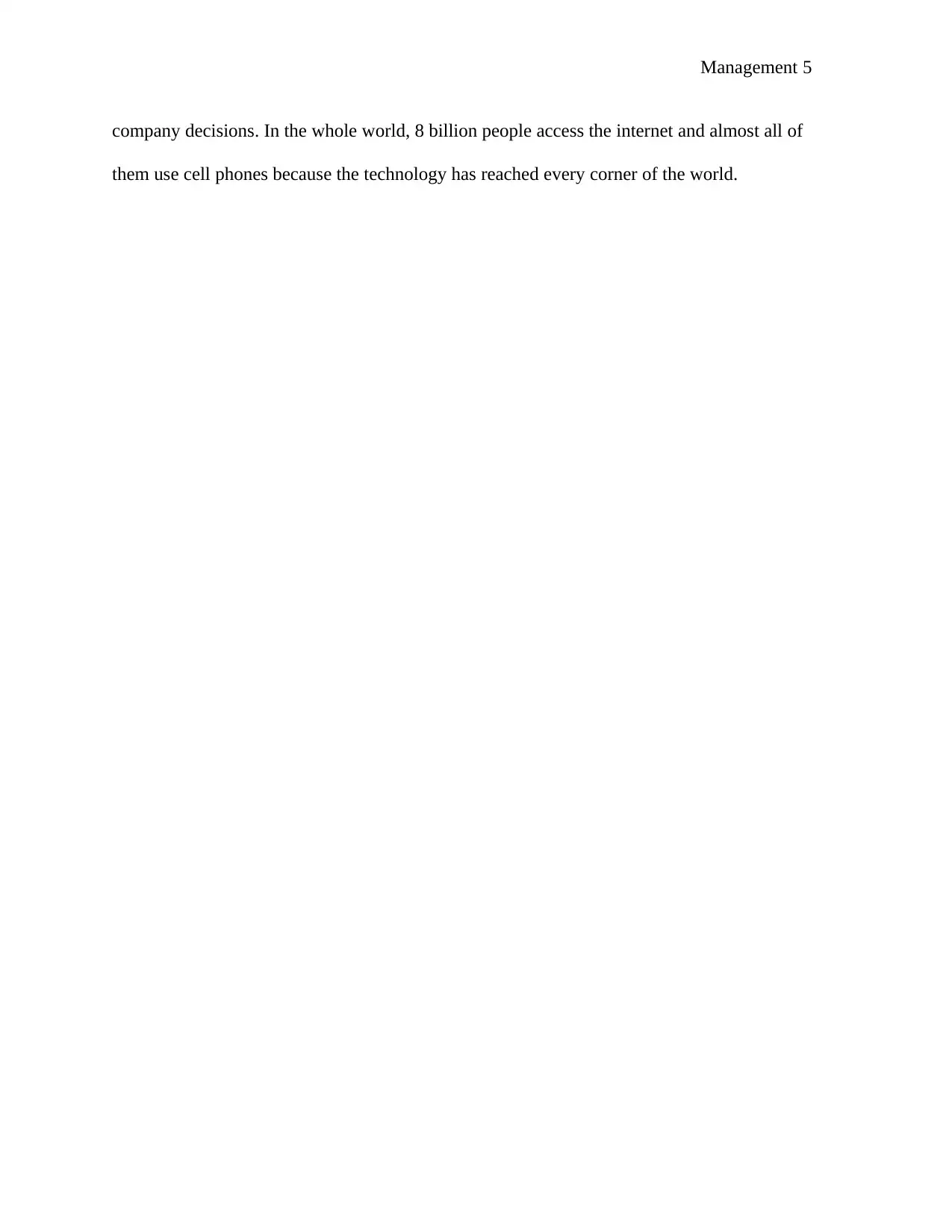
Management 5
company decisions. In the whole world, 8 billion people access the internet and almost all of
them use cell phones because the technology has reached every corner of the world.
company decisions. In the whole world, 8 billion people access the internet and almost all of
them use cell phones because the technology has reached every corner of the world.
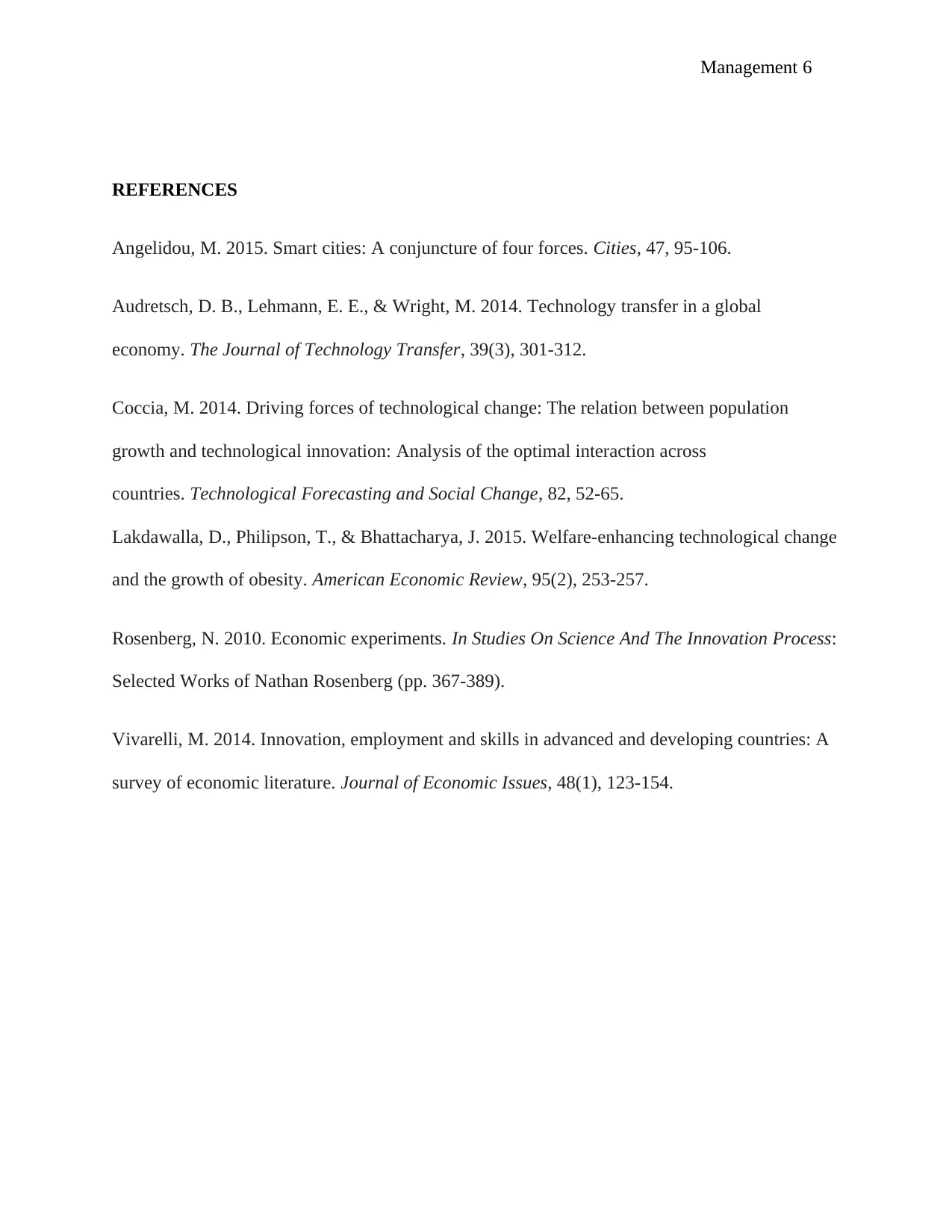
Management 6
REFERENCES
Angelidou, M. 2015. Smart cities: A conjuncture of four forces. Cities, 47, 95-106.
Audretsch, D. B., Lehmann, E. E., & Wright, M. 2014. Technology transfer in a global
economy. The Journal of Technology Transfer, 39(3), 301-312.
Coccia, M. 2014. Driving forces of technological change: The relation between population
growth and technological innovation: Analysis of the optimal interaction across
countries. Technological Forecasting and Social Change, 82, 52-65.
Lakdawalla, D., Philipson, T., & Bhattacharya, J. 2015. Welfare-enhancing technological change
and the growth of obesity. American Economic Review, 95(2), 253-257.
Rosenberg, N. 2010. Economic experiments. In Studies On Science And The Innovation Process:
Selected Works of Nathan Rosenberg (pp. 367-389).
Vivarelli, M. 2014. Innovation, employment and skills in advanced and developing countries: A
survey of economic literature. Journal of Economic Issues, 48(1), 123-154.
REFERENCES
Angelidou, M. 2015. Smart cities: A conjuncture of four forces. Cities, 47, 95-106.
Audretsch, D. B., Lehmann, E. E., & Wright, M. 2014. Technology transfer in a global
economy. The Journal of Technology Transfer, 39(3), 301-312.
Coccia, M. 2014. Driving forces of technological change: The relation between population
growth and technological innovation: Analysis of the optimal interaction across
countries. Technological Forecasting and Social Change, 82, 52-65.
Lakdawalla, D., Philipson, T., & Bhattacharya, J. 2015. Welfare-enhancing technological change
and the growth of obesity. American Economic Review, 95(2), 253-257.
Rosenberg, N. 2010. Economic experiments. In Studies On Science And The Innovation Process:
Selected Works of Nathan Rosenberg (pp. 367-389).
Vivarelli, M. 2014. Innovation, employment and skills in advanced and developing countries: A
survey of economic literature. Journal of Economic Issues, 48(1), 123-154.
⊘ This is a preview!⊘
Do you want full access?
Subscribe today to unlock all pages.

Trusted by 1+ million students worldwide
1 out of 6
Related Documents
Your All-in-One AI-Powered Toolkit for Academic Success.
+13062052269
info@desklib.com
Available 24*7 on WhatsApp / Email
![[object Object]](/_next/static/media/star-bottom.7253800d.svg)
Unlock your academic potential
Copyright © 2020–2025 A2Z Services. All Rights Reserved. Developed and managed by ZUCOL.




